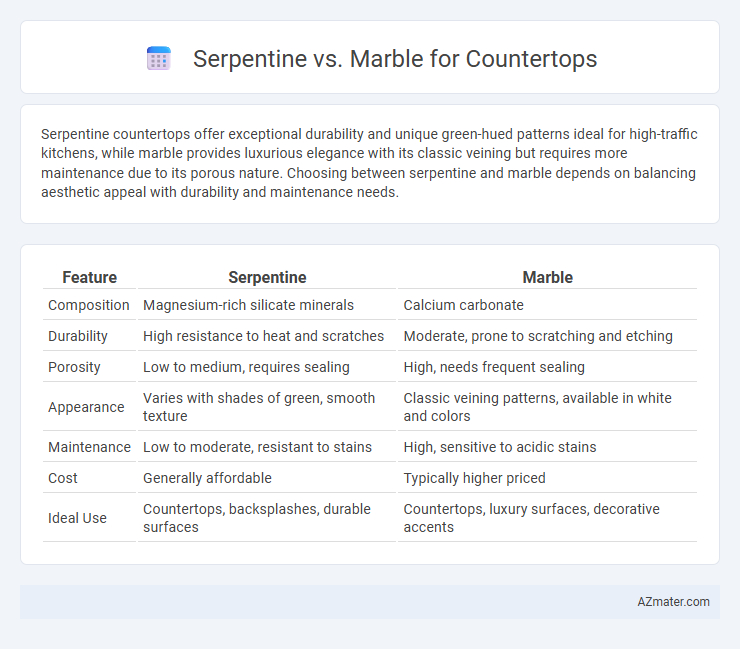Serpentine countertops offer exceptional durability and unique green-hued patterns ideal for high-traffic kitchens, while marble provides luxurious elegance with its classic veining but requires more maintenance due to its porous nature. Choosing between serpentine and marble depends on balancing aesthetic appeal with durability and maintenance needs.
Table of Comparison
| Feature | Serpentine | Marble |
|---|---|---|
| Composition | Magnesium-rich silicate minerals | Calcium carbonate |
| Durability | High resistance to heat and scratches | Moderate, prone to scratching and etching |
| Porosity | Low to medium, requires sealing | High, needs frequent sealing |
| Appearance | Varies with shades of green, smooth texture | Classic veining patterns, available in white and colors |
| Maintenance | Low to moderate, resistant to stains | High, sensitive to acidic stains |
| Cost | Generally affordable | Typically higher priced |
| Ideal Use | Countertops, backsplashes, durable surfaces | Countertops, luxury surfaces, decorative accents |
Introduction to Serpentine and Marble Countertops
Serpentine countertops are crafted from serpentine minerals, known for their distinctive green tones and smooth, silky texture that offers a unique alternative to traditional natural stones. Marble countertops, made from recrystallized carbonate minerals, are prized for their elegant veining and classic white, gray, and beige hues, adding timeless sophistication to kitchens and bathrooms. Both materials require sealing to protect against staining and etching, with serpentine offering enhanced resistance to heat and acids compared to marble.
Geological Origins and Composition
Serpentine countertops derive from ultramafic rocks rich in magnesium and iron silicates, formed through the metamorphism of peridotite and other mantle-derived rocks. Marble originates from the metamorphosis of limestone or dolomite, primarily consisting of recrystallized calcite or dolomite minerals. The distinct geological origins affect their composition, with serpentine exhibiting a greenish hue due to its magnesium content and marble displaying a range of colors from white to pink based on impurities.
Appearance and Aesthetic Differences
Serpentine countertops boast rich green hues with intricate swirling patterns that create a dynamic, natural look, while marble countertops display elegant white or light backgrounds with distinctive veining in shades of gray, black, or gold. The smooth, waxy texture of serpentine offers a matte to semi-gloss finish, contrasting with marble's typically polished, high-gloss surface that enhances its classic, luxurious appeal. Choosing between serpentine and marble depends on desired color depth and pattern complexity, with serpentine providing a more exotic and earthy aesthetic and marble delivering timeless sophistication.
Durability and Hardness Comparison
Serpentine countertops offer moderate durability with a Mohs hardness rating of about 3 to 4, making them more prone to scratches and etching compared to marble. Marble exhibits a hardness of approximately 3 to 4 as well but tends to be slightly more durable under wear due to its crystalline structure, though it is sensitive to acidic substances causing surface damage. For long-term countertop use, marble generally provides better resistance to chipping and impact, while serpentine requires more careful maintenance to preserve its finish.
Stain, Scratch, and Heat Resistance
Serpentine countertops offer moderate stain resistance but require regular sealing to prevent discoloration, while marble is highly porous and prone to staining without proper care. When it comes to scratches, serpentine is relatively harder and more scratch-resistant compared to the softer, more easily scratched surface of marble. Heat resistance is better in serpentine, which can withstand higher temperatures without damage, whereas marble can suffer from thermal shock and etching when exposed to hot pans or direct heat.
Maintenance and Care Requirements
Serpentine countertops require regular sealing due to their porous nature, making them more prone to staining and etching compared to marble. Marble, while beautiful and more heat resistant, demands frequent sealing and gentle cleaning with pH-neutral products to prevent surface damage and discoloration. Both materials benefit from using cutting boards and avoiding acidic spills to extend their durability and maintain their aesthetic appeal.
Cost and Value Considerations
Serpentine countertops typically offer a lower cost compared to marble, making them an attractive option for budget-conscious homeowners seeking natural stone aesthetics. While marble is prized for its classic beauty and unique veining, its higher price and maintenance requirements can impact long-term value. Evaluating cost-effectiveness involves balancing serpentine's affordability and durability against marble's timeless appeal and potential to increase property value.
Environmental Impact and Sourcing
Serpentine countertops have a lower environmental impact due to their abundant availability and less intensive quarrying process compared to marble, which often requires energy-heavy extraction and transportation from limited geographic regions. Marble mining typically results in significant habitat disruption and higher carbon emissions, whereas serpentine's extraction is generally more sustainable and less environmentally damaging. Choosing serpentine supports reduced ecological footprints and promotes responsible sourcing practices within the natural stone industry.
Popular Design Applications
Serpentine countertops feature rich, variable patterns with deep green hues that enhance contemporary kitchen designs and add a unique, natural aesthetic. Marble is prized for its elegant, classic veining and smooth surface, widely used in traditional and luxurious bathroom vanities and upscale kitchen islands. Both materials offer distinct visual appeal, with serpentine suiting bold, organic interiors, while marble complements timeless, sophisticated decor styles.
Choosing Between Serpentine and Marble Countertops
Serpentine countertops offer exceptional durability and resistance to heat and scratches, making them ideal for high-traffic kitchen environments, whereas marble countertops are prized for their timeless elegance and unique veining but require more maintenance due to their porosity and susceptibility to staining. Choosing between serpentine and marble depends on balancing aesthetic preference with practical considerations such as durability, maintenance, and cost. Homeowners seeking a luxurious yet resilient surface often prefer serpentine, while those prioritizing classic beauty and willing to invest in upkeep lean toward marble countertops.

Infographic: Serpentine vs Marble for Countertop
 azmater.com
azmater.com